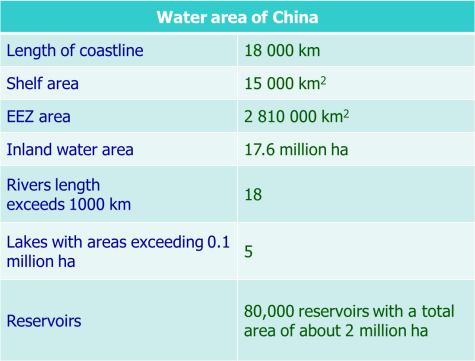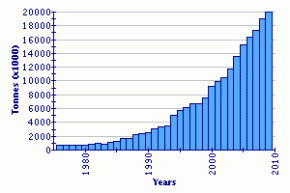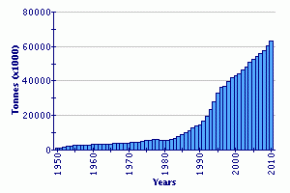As the third biggest country in the world, China enjoys not only vast territory but rich water areas as well. The nature provide great potential to fishery, either wild caught or aquaculture.

Source: Fishery and Aquaculture Country Profiles: The People’s Republic of China ftp://ftp.fao.org/FI/DOCUMENT/fcp/en/FI_CP_CN.pdf
Significant production from both capture and aquaculture results in significant figures of fishery trade and commodity, which is not only the pillar of every local fishery village but also an essential component of the economy of the country. Looking for a sustainable strategy of fishery is at great importance.

China Fishery Commodity and Trade Statistics Source: FAO Fisheries statistics http://www.fao.org/fishery/facp/CHN/en

China Production
Source: FAO Fisheries statistics http://www.fao.org/fishery/facp/CHN/en
Both wild caught and aquaculture have their own pros and cons. As a country with large marine and fresh water areas, seeking balance is always the way to go. However, it might be better for China to weigh aquaculture more.
Aquaculture VS Wild Caught
- Space
Capture:
Even we have a vast Exclusive Economic Zone, there is a cap. Meanwhile, we share the ocean with other countries as Korea, Japan, Philippines, Malaysia, etc. Reports could be seen frequently that fishermen run into conflict with other countries’ vessels and even warships.
Aquaculture:
Still, we could not expand unlimitedly but the cap is not that obvious. In addition, with policy support and technology support, it is possible to utilize the space more efficiently.
- Efficiency
Capture:
For the good of ecosystem, every summer for about 3 months there is the fish moratorium.
Inevitable by-catch is another problem both economically and environmentally.
There are certain species in the natural waters that are not controllable. Its adaptability to the market is limited.
Aquaculture:
No moratorium and no by-catch.
High adaptability to the market.
- Safety
Though disease and contamination may affect both capture production and aquaculture production. It is much safer for the people who are in aquaculture than those in wild caught. The potential casualty may raise the cost of the products.
Aquaculture is not only embracing a promising future theoretically, the actual statistics also show a steady growth, comparing with the capture production. Its controllability makes it stand out in the market economy. As the biggest aquatic production trading nation in the world, more efficient aquaculture is definitely the path to the sustainable development.

Source: China Statistical Yearbook 2009 http://www.thefishsite.cn/articles/535/%E4%B8%AD%E5%9B%BD%E6%B0%B4%E4%BA%A7%E4%BA%A7%E5%93%81%E5%B9%B4%E5%BA%A6%E6%8A%A5%E5%91%8A